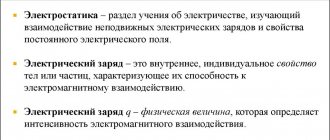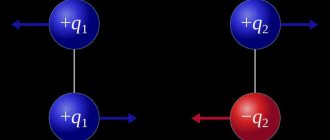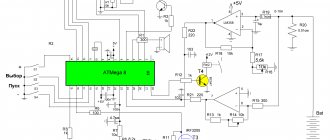Job.
Let a constant force act on the body and the body, moving rectilinearly along a horizontal surface, has made a displacement.
Force is not necessarily the direct cause of movement (thus, gravity is not the direct cause of movement of a cabinet that is moved across a room). Let us first assume that the vectors of force and displacement are codirectional (Fig. 1; other forces acting on the body are not indicated)
| Rice. 1.A=Fs |
In this simplest case, work is defined as the product of the force modulus and the displacement modulus:
. (1)
The unit of measurement for work is the joule (J): J = N m. Thus, if under the influence of a force of 1 N a body moves 1 m, then the force does 1 J of work.
The work done by a force perpendicular to the displacement is considered to be zero by definition. So, in this case, the force of gravity and the reaction force of the support do not do any work.
Let now the force vector form an acute angle with the displacement vector (Fig. 2).
| Rice. 2. A=Fs cos |
Let us decompose the force into two components: (parallel to the displacement) and (perpendicular to the displacement). Only does the work. Therefore, for the work of force we obtain:
. So,
. (2)
If the force vector forms an obtuse angle with the displacement vector, then the work is still determined by formula (2). In this case, the work turns out to be negative.
For example, the work of the sliding friction force acting on the body in the situations considered will be negative, since the friction force is directed opposite to the movement. In this case we have:
, and for the work of the friction force we obtain:
,
where is the body mass, is the coefficient of friction between the body and the support.
Relationship (2) means that work is the scalar product of the force and displacement vectors:
.
This allows work to be calculated through the coordinates of these vectors:
.
Let several forces act on a body and let the resultant of these forces be. For the work of force we have:
,
or
,
where is the work of forces. So, the work of the resultant forces applied to the body is equal to the sum of the work of each force separately.
Work of electric current
As the current passes through the circuit, it does work. For example, if a water stream is directed to flow onto the generator blades, then the pon will do work by rotating the blades. In the same way, current does work moving through a conductor. And this work is higher, the greater the current and voltage. The work of electric current performed on a section of a circuit is directly proportional to the current strength, voltage and time of current action. The work of electric current is denoted by the Latin symbol A. Since the product I×U is power, the formula for the work of electric current can be written: A = P×t
It will be interesting➡ Phantom power for a microphone: connection diagram
The unit of measurement for the work of electric current is the watt in seconds or in joules. Therefore, if we want to calculate how much work has been done by the current flowing through the circuit during a time interval, we must multiply the power by the time. Consider a practical example, a current of 0.5 A flows through a rheostat with a resistance of 5 Ohms. We need to calculate how much work will be done by current for four hours. Work for one second will be: P=I2R = 0.52×5= 0.25×5 =1.25 W,
Then in 4 hours t=14400 seconds. Therefore: A = P×t= 1.25×14,400= 18,000 watt-second. A watt-second or one joule is considered too small a quantity to measure work. Therefore, in practice, a unit called watt-hour (Wh) is used. One watt-hour is equivalent to 3,600 J. In electrical engineering, even larger units are used, hectowatt-hour (gWh) and kilowatt-hour (kWh): 1 kWh = 10 GWh = 1000 Wh = 3,600,000 J, 1 GWh = 100 Wh = 360,000 J, 1 Wh = 3,600 J.
Electric current power
How to calculate resistance and power
Let's say you need to select a current-limiting resistor for the power supply of a lighting circuit. We know the supply voltage of the on-board network “U”, equal to 24 volts, and the current consumption “I” of 0.5 amperes, which cannot be exceeded. Using expression (9) of Ohm’s law, we calculate the resistance “R”. R=24/0.5=48 Ohm. At first glance, the resistor value is determined. However, this is not enough. For reliable operation of the sema, it is necessary to perform a power calculation based on current consumption.
According to the Joule-Lenz law, the active power “P” is directly proportional to the current “I” passing through the conductor and the applied voltage “U”. This relationship is described by the formula P = 24x0.5 = 12 W.
The calculation of the resistor power based on its current consumption shows that in the selected circuit it is necessary to use a resistance of 48 Ohms and 12 W. A resistor of lower power will not withstand the applied loads, will heat up and burn out over time. This example shows the dependence of how the load current and network voltage influence the consumer power.
Interesting read: everything about Ohm's law.
Power.
The speed with which work is done often matters.
Let's say, in practice, it is important to know what work a given device can perform in a fixed time. Power is a quantity that characterizes the speed at which work is done. Power is the ratio of work to the time during which this work is done:
.
Power is measured in watts (W). 1 W = 1 J/s, that is, 1 W is the power at which 1 J of work is done in 1 s.
Let us assume that the forces acting on the body are balanced, and the body moves uniformly and rectilinearly with speed . In this case, there is a useful formula for the power developed by one of the acting forces.
Over time, the body will move. The work done by the force will be equal to:
.
From here we get the power:
,
or
,
where is the angle between the force and velocity vectors.
This formula is most often used in a situation where - the “traction” force of a car engine (which is actually the friction force of the drive wheels on the road). In this case, and we get simply:
.
What is power in electricity
Mechanical power as a physical quantity is equal to the ratio of work performed to a certain period of time. Since the concept of work is determined by the amount of energy expended, it is also possible to represent power as the rate of energy conversion. Having analyzed the components of mechanical power, let’s consider what electrical power is made up of. Voltage is the work done to move one coulomb of electric charge, and current is the number of coulombs passing in one second. The product of voltage and current shows the total amount of work done in one second.
Electric current power is a quantitative measure of current that characterizes its energy properties. It is determined by the main parameters - current and voltage. The power of electric current is measured with a device called a Wattmeter. The unit of measurement is Watt (W).
Having analyzed the resulting formula, we can conclude that the power indicator depends equally on current and voltage. That is, the same value can be obtained at low voltage and high current, or at high voltage and low current. Taking advantage of the dependence of power on voltage and current, engineers have learned to transmit electricity over long distances by converting energy at step-down and step-up transformer substations.
Science divides electrical power into:
- active. It involves the conversion of power into thermal, mechanical and other types of energy. The indicator is expressed in Watts and calculated using the formula U*I;
- reactive. This value characterizes the electrical loads created in devices by fluctuations in the energy of the electromagnetic field. The indicator is expressed as reactive volt-amperes and is the product of voltage by force and shear angle.
To make it easier to understand the meaning of active and reactive power, let us turn to heating equipment, where electrical energy is converted into thermal energy.
Material on the topic: what is an electrical circuit.
How to measure power
It is always necessary to know the power characteristics of household equipment. This is required to calculate the wiring cross-section, take into account electricity consumption or electrify the house. Before installation work begins, such information can only be obtained by adding up the power indicators of each individual device, adding a 10% margin.
It will be interesting➡ Kirchhoff's laws in simple words: definition for an electrical circuit
A meter will help determine the consumed load at home. The device shows how many kilowatts were spent in one hour of equipment operation. And in order to ensure that the readings are correct, the apartment owner can check the accuracy of the device using electronic measuring instruments. This includes an ammeter, voltmeter or multimeter.
There are also wattmeters and varmeters that display measurement results in watts. While taking readings, leave only active loads such as light bulbs and heaters on. Next, measure the current voltage. At the end, check the meter readings with the resulting calculation results.
Mechanical energy.
Energy is a measure of the movement and interaction of any objects in nature.
There are various forms of energy: mechanical, thermal, electromagnetic, nuclear. . . Experience shows that energy does not appear out of nowhere and does not disappear without a trace, it only passes from one form to another. This is the most general formulation of the law of conservation of energy.
Each type of energy represents some mathematical expression. The law of conservation of energy means that in every natural phenomenon a certain sum of such expressions remains constant over time.
Energy is measured in joules, just like work.
Mechanical energy is a measure of the movement and interaction of mechanical objects (material points, solid bodies).
The measure of the motion of a body is kinetic energy. It depends on the speed of the body. The measure of interaction between bodies is potential energy. It depends on the relative position of the bodies.
The mechanical energy of a system of bodies is equal to the sum of the kinetic energy of the bodies and the potential energy of their interaction with each other.
Types of mechanical energy
In mechanics, the state of a system is determined by the position of bodies and their velocities. Therefore, there are two types of energy in it: potential and kinetic.
Determination of kinetic energy
Kinetic energy is the energy possessed by a moving body. It is designated as Ek. The kinetic energy of a body depends on its mass and speed. Numerically, it is equal to half the product of the mass of the body and the square of its speed:
Determination of potential energy
Potential energy is the energy of interacting bodies. It is designated as Ep.
The potential energy in the Earth's gravitational field is numerically equal to the product of the mass of the body by its height (distance from the surface of the planet) and the acceleration of gravity:
Ep=mgh
The potential energy of an elastically deformed body is determined by the formula:
Ep=kx22..
k is the spring stiffness, x is its elongation.
Example No. 1. A boy threw a soccer ball weighing 0.4 kg to a height of 3 m. Determine its potential and kinetic energy at the top point.
The potential energy of the ball in the Earth's gravitational field is equal to:
Ep = mgh = 0.4∙10∙3 = 12 (J)
At the top point of flight, the speed of the ball is zero. Therefore, the kinetic energy of the ball at this point will also be zero:
Ek = 0 (J).
Kinetic energy.
The kinetic energy of a body (taken as a material point) is the quantity
,
where is the mass of the body and is its speed.
The kinetic energy of a system of bodies is the sum of the kinetic energies of each body:
.
If a body moves under the influence of a force, then the kinetic energy of the body, generally speaking, changes with time. It turns out that the change in the kinetic energy of a body over a certain period of time is equal to the work done by the force. Let us show this for the case of rectilinear uniformly accelerated motion.
Let be the initial speed and let be the final speed of the body. Let us choose an axis along the trajectory of the body (and, accordingly, along the force vector). For the work of force we get:
.
(we used the formula for , derived in the article “Uniformly Accelerated Motion”). Let us now note that in this case the velocity projection differs from the velocity module except in sign; that's why . As a result we have:
,
which is what was required.
In fact, the relationship is also valid in the most general case of curvilinear motion under the influence of a variable force.
Theorem about kinetic energy. The change in the kinetic energy of a body is equal to the work done by external forces applied to the body during the period of time under consideration.
If the work of external forces is positive, then the kinetic energy increases (the body accelerates).
If the work of external forces is negative, then the kinetic energy decreases (the body slows down). An example is braking under the influence of friction, the work of which is negative.
If the work of external forces is zero, then the kinetic energy of the body does not change during this time. A non-trivial example is uniform circular motion performed by a load on a string in a horizontal plane. Gravity, ground reaction force, and thread tension are always perpendicular to the speed, and the work done by each of these forces is zero for any period of time. Accordingly, the kinetic energy of the load (and therefore its speed) remains constant during movement.
Task. A car is driving along a horizontal road at speed and begins to brake sharply. Find the distance traveled by the car until it comes to a complete stop if the coefficient of friction between the tires and the road is equal to .
Solution. Initial kinetic energy of the car, final kinetic energy. Change in kinetic energy.
The car is affected by gravity, ground reaction and friction. The force of gravity and the reaction of the support, being perpendicular to the movement of the car, do no work. Work of friction force:
.
From the kinetic energy theorem we now obtain:
.
Kinetic energy theorem
Theorem on kinetic energy
The change in the kinetic energy of a body is equal to the work of the resultant of all forces acting on the body:
This theorem is valid regardless of what forces act on the body: elasticity, friction or gravity.
Example No. 2. The speed of a moving car weighing 1 ton changed from 10 m/s to 20 m/s. What is the work done by the resultant force?
First, let's convert the units of measurement to SI: 1 t = 1000 kg. Work is equal to the change in kinetic energy, therefore:
Potential energy of a deformed spring.
Let's consider the stiffness spring.
The initial deformation of the spring is . Let us assume that the spring is deformed to some finite amount of deformation. What is the work done by the elastic force of the spring? In this case, the force cannot be multiplied by the displacement, since the elastic force changes during the deformation of the spring. To find the work done by a variable force, integration is required. We will not give the conclusion here, but will immediately write down the final result.
It turns out that the spring force is also conservative. Its work depends only on the quantities and is determined by the formula:
.
Magnitude
is called the potential energy of a deformed spring (x is the amount of deformation).
Hence,
,
which is completely similar to formulas (3) and (4).
Work and potential energy of a body raised above the Earth
The amount of potential energy depends on the choice of the zero energy level. In the Earth's gravitational field, a body located on the surface of the planet has a zero energy level.
Work of gravity
The work done by gravity is equal to the change in the potential energy of the body, taken with the opposite sign:
A = – ∆Ep = –(mgh – mgh0) = mg(h0 – h)
If a body rises, gravity does negative work. If a body falls, gravity does positive work.
Example No. 3. A ball weighing 100 g rolled down a hill 2 m long, making an angle of 30° with the horizontal. Determine the work done by gravity.
First, let's convert the units of measurement to SI: 100 g = 0.1 kg. Under the influence of gravity, the position of the body relative to the Earth has changed by an amount equal to the height of the slide. We can find the height of the slide by multiplying its length by the sine of the angle of inclination. The initial height is equal to the height of the slide, the final height is zero. From here:
A = mg(h0 – h) = 0.1∙10(2∙sin30o – 0) =2∙0.5 = 1 (J)
Potential energy of an extended body
Work of gravity
The potential energy of an extended body is expressed through its center of mass. For example, to lift a crowbar with length l and mass m, you need to do work equal to:
A = mgh
where h is the height of the center of mass of the scrap above the Earth's surface. Since the crowbar is uniform along its entire length, its center of mass will be located midway between its ends, or:
Hence the work that needs to be done to lift this crowbar will be equal to:
Example No. 4. The student lifted a 0.5 m long ruler lying on the table by one end so that it was in a vertical position. What is the minimum amount of work done by the student if the mass of the ruler is 40 g?
Let's convert the units of measurement to SI: 40 g = 0.04 kg. The minimum work required to lift a ruler at one end is:
Law of conservation of mechanical energy.
Conservative forces are so called because they conserve the mechanical energy of a closed system of bodies.
The mechanical energy of a body is equal to the sum of its kinetic and potential energies:
.
The mechanical energy of a system of bodies is equal to the sum of their kinetic energies and the potential energy of their interaction with each other.
Let us assume that the body moves under the influence of gravity and/or the elastic force of a spring. We will assume that there is no friction. Let the kinetic and potential energies of the body be equal to and in the initial position, and and in the final position. We denote the work of external forces when moving a body from the initial position to the final position.
According to the kinetic energy theorem
.
But the work of conservative forces is equal to the difference in potential energies:
.
From here we get:
,
or
.
The left and right sides of this equality represent the mechanical energy of the body in the initial and final position:
.
Consequently, when a body moves in a gravity field and/or on a spring, the mechanical energy of the body remains unchanged in the absence of friction. A more general statement is also true.
Law of conservation of mechanical energy . If only conservative forces act in a closed system, then the mechanical energy of the system is conserved.
Under these conditions, only energy transformations can occur: from kinetic to potential and vice versa. The total supply of mechanical energy of the system remains constant.
Law of energy conservation
The energy of a closed physical system is conserved. A closed system is a system in which only conservative forces act.
Law of conservation of mechanical energy
The total amount of potential and kinetic energy of a body remains unchanged if only the forces of elasticity and gravity act and there is no frictional force.
Ekin+Epot=const
Potential energy in the gravity field is expressed by the formula:
Epot=mgh
where m is body weight, [kg],
g is the acceleration of gravity, [N/kg] or [m/s2].
h is the height of the body above the surface, [m].
Any position convenient for us can be taken as the zero position of the body, depending on the conditions, experiments and measurements. This could be the surface of the floor, table, Earth, and so on.
Law of conservation of energy for a mathematical pendulum
The law of conservation of energy in the field of gravity is well illustrated by the movement of a mathematical pendulum.
In positions 1 and 3, the ball is at rest at a height h, its kinetic energy is zero, and its potential energy is mgh. When moving from position 1 to position 2, the height and potential energy decrease, but the speed and kinetic energy increase, and in position 2 the kinetic energy is maximum and equal to mv2/2, and the potential energy is minimum and equal to zero.
Thus,
A load raised above the ground does not do work, but it can do it if it starts to fall down. For example, the potential energy of falling water can be converted into mechanical energy from a millstone.
What is electric power
Any physical action is performed under the influence of force. With its help, a certain path is followed, that is, work is performed. In turn, the work A done during a certain time t will amount to the power value expressed by the formula: N = A/t (W = J/s). Another concept of power is related to the rate of energy conversion of a particular system. One of these transformations is the power of electric current, with the help of which many different works are also performed. First of all, it is associated with electric motors and other devices that perform useful actions.
Current power is related to several physical quantities at once. Voltage (U) represents the work required to move 1 coulomb. The current strength (I) corresponds to the number of coulombs passing in 1 second. Thus, the current multiplied by the voltage (I x U) corresponds to the total work done in 1 second. The resulting value will be the power of the electric current.
The given formula for current power shows that power is equally dependent on current and voltage. It follows that the same value of this parameter can be obtained due to high current and low voltage and, conversely, at high voltage and low current. This property makes it possible to transmit electricity over long distances from sources to consumers. During the transmission process, the current is converted using transformers installed at step-up and step-down substations.











